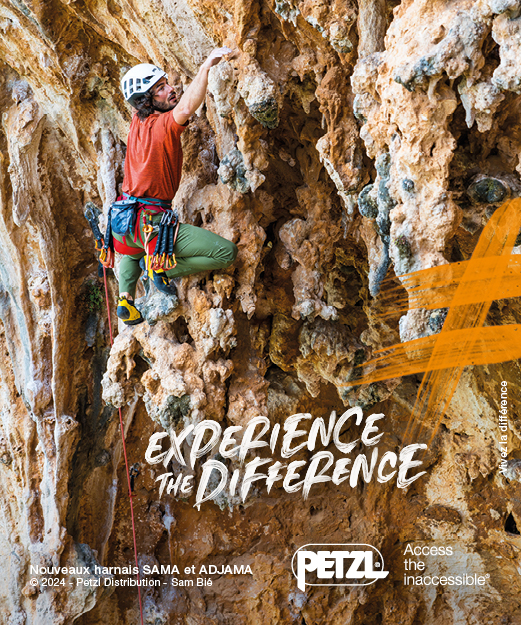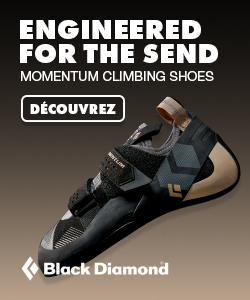Patagonia Micro Puff Jacket : heat and light

Patagonia has just brought out an even lighter and even more compressible jacket than the classic Nano Puff. The Micro Puff Jacket is a real award-winner! We at the Fabrique Verticale got to see it at the OutDoor and ISPO 2018 trade fairs and we couldn’t get over how light it is. And obviously we wanted to test it for real when we were climbing. So what’s the verdict?
Down or synthetic?
This debate has been going on forever among climbers who head outdoors during the winter. What jacket to take to keep cosy between runs or when you’re belaying? Globally, downies are considered to be more effective against the cold. But they are less compressible. And they can look a bit ‘chunky’. Also, they lose their heat retaining properties when it rains…
The miracle solution?
Climbing in the cold and getting your clothing right in winter is no easy task. Especially if you are used to climbing in the gym 😉 After many years’ experience, we have come to this conclusion: for belaying or spotting, the best thing is to have a good stock of warm clothing (down jacket, windcheater, beanie, scar, gloves, warm socks…). And to layer up, but taking care not to be too constricted, so as not to impede circulation.

Then, during the climbing phases, consider yourself an onion. Peel off the layers. When you are climbing, just keep on one or two layers that give freedom of movement. For example, a long sleeved base layer plus a tee shirt and/or sleeveless jacket. Or if it’s really cold, do the same thing with an extra layer that is very light and very warm, such as the Nano Puff Hoody, to compare with another Patagonia product, as your outer layer.
What we tested and in what conditions.
So that we could test Patagonia’s new Micro Puff, we ordered two Jackets, which are the hoodless version. We tested them outdoors, on boulder and crag. But we also went back country skiing and even did some high-altitude bouldering with them, near the Asco ski resort in Corsica. In the snow, because we’re mental 😉

For the moment, we haven’t tested them on multi-pitch routes, because the weather has been somewhat unpredictable this spring, even in Corsica… We will keep you posted, of course, between now and the summer, when we get back to it. Meanwhile, we just checked that you could wear the garment with a harness, without compromising on comfort.

Weight and compactness
The first impression when you put the jacket on is how incredibly light it feels. Only 235g! As a comparison, the Nano Puff Hoody, which hardly weighs anything in the first place, is a third heavier. In other words, Patagonia’s Micro Puff won’t be weighing you down on your runs 😉

Which makes it ideal for multi-pitches (compressible, light, easy to carry). And we really need to try it out in that context. Because when it comes to packing, Patagonia’s Micro Puff is just astonishing. The jacket folds easily, so it takes up very little space. The left pocket becomes a stuffsack, with a reinforced carabiner clip-in loop, ideal for clipping the jacket to your harness (and for putting it back on at the anchor if it’s windy).

Using synthetic materials in the Micro Puff design is a major advantage in terms of compressibility. The entire garment is easily compressed, but without losing its heat retaining properties. Obviously, you can compress a down jacket too, but feathers can get damaged in the process, so it loses its fluffiness and, in time, heat. And it’s not exactly the same when you have to put it in your climbing bag…

The shape
Patagonia has pulled it off with the Micro Puff. Nicely shaped, it enables a wide range of movements, even with a fairly thick base layer underneath. And possibly a fleece too. There’s no restriction to your movements. I was a little surprised by the shape at the beginning, because the jacket is quite long. It nearly comes down below my buttocks, even though the arm length is perfect. But, this turns out to be an advantage, because it really keeps the heat in, and it doesn’t look odd.

Heat/Comfort
The jacket has two generously sized, zipped handwarmer pockets, which are in line with the seams to save on weight. And the jacket opens via a front zip, with an interior storm flap. The zip garage is comfortable at the chin when the jacket is fully zipped up. Overall, it works well. Nothing new, I hear you say. But the functionality is definitely there.

If you’re looking for innovation, Patagonia’s Micro Puff uses PlumaFill technology, cutting edge quilting which strengthens insulation and maximises puffiness. On paper, the Jacket is said to be as warm as a down jacket. Just the material changes, since this is synthetic fabric.
Having said that, even though the jacket is very pleasant to wear, someone who feels the cold will notice a little difference on the heat retention front. With the advantage going to the down jacket in terms of perceived warmth. So what you gain in lightness and compactness, you lose a bit in insulation strength. We would therefore tend to say that Patagonia’s Micro Puff will be perfect for mid-season, or for multi-pitches in the summer. But in any case, it’s more of an intermediate layer than an outer garment!
Coping with drizzle
One of the advantages of synthetic fabrics, is that they retain their heat-retaining properties, even when wet. This is a major plus over a down jacket, especially if you’re climbing outdoors in unpredictable weather conditions, with a few passing showers for example. At Font in winter maybe, or in the Peak District 😉 To be honest, since we got the jackets, we haven’t had to deal with those kinds of outdoor conditions.
But the water repellent fabric should hold up to a light drizzle without ay problem. In our experience, having used Patagonia’s Nano Puffs in wet weather, the result is quite incredible, and they are aimed at roughly the same niche. They are obviously not wet weather gear, but even when wet, you still feel warm, and they dry out really quickly! Which is not the case with down jackets…

Wind resistance
We may not have been able to test the Patagonia Micro Puffs in the drizzle, but we certainly got to see how they hold up to the wind. This is a “weather constant” in Corsica, and it can turn a pleasant sunny day into a freezing nightmare, as the infamous wind chill factor increases the perception of cold.
On this aspect, Patagonia Micro Puff Jackets score some points. The Pertex Quantum GL fabric certainly does its wind-breaking job. It blocks the air, even in heavy gusts. The minimalist seams and insulation design, with a system of alternating quilting, limit heat loss. It also keeps the insulation material fluffy, and therefore relatively warm.
Durability
Since we’re talking about an ultra-light jacket, you could suspect it of being prone to damage by abrasion or tearing. Usually, we’re a bit worried that, in a showdown between ultra-fine material and brushland or Corsican granite, it’ll be nature that wins out 😉 So how did the Patagonia Micro Puff Jackets fare? We’ve only been using them since February, so it’s difficult to make any conclusions about its durability.

However, we did climb outdoors in them and tested them as an outer layer, even though they’re more of an intermediate layer garment. The smooth fabric has a slightly cracked appearance, and it could make you fear the worst. Especially up against rock, for example when you’re pushing up on a boulder. But no damage to report! Now we need to see how they stand up to our cats;-)

In summary
Downsides
- A little less warm than a down jacket, for a similar price
- the price, 250 € for the Jacket version
Upsides
- Incredibly light
- Really compressible
- Quick drying









Hi guys, loved your review and on the job test, excellent well done and thankyou!!
I was wondering if you could tell what size jacket you used for the review, is yours tight around your neck? mine is almost choking me when zipped up fully. Should i be able to pull the neck up over my chin or is it normal for it to be very tight, not actually throttling me but too tight to get over my chin? Is it warm enough to wear in minus 1 – 5 with just a t-shirt on? Would appreciate your feedback, have just pur hased a size – medium – mens patagonia micro puff jacket – i am 5ft 11″, i weigh approximately 12 stone am 50 yrs old now and in average fitness level. Thanks in advance guys
Hi ! thanks for your comment ! I use a size S. I’m 1,77 meters tall and 62 kg. And yes, it is tight around my neck (not too much :-)) ). at minus 1-5, I think it’s enough if you move. If you don’t move, need another layer maybe :-).
Thankyou for your reply, much appreciated!